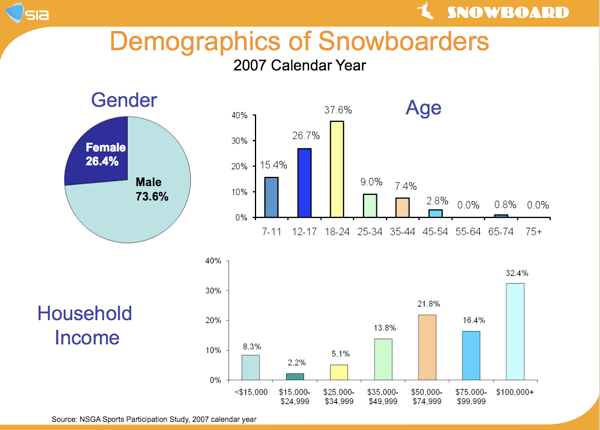Snowboard innovation
From DDL Wiki
(→Market Analysis) |
(→Market Analysis) |
||
| Line 13: | Line 13: | ||
| - | The general trend is that snowboarders tend to be young, male and rich. In the U.S. only 6% of the population make more than a 100,000$ per year [http://www.usdta.org/the-average-income-in-the-usa.php], compared to 32,4% of snowboarders. A detachable snowboard will be more expensive than a regular board, however snowboarders being a rich demographic will be less influenced by price increases if they can be convinced of the advantages of the new design. Therfore we believe the cost increase will not deter | + | The general trend is that snowboarders tend to be young, male and rich. In the U.S. only 6% of the population make more than a 100,000$ per year [http://www.usdta.org/the-average-income-in-the-usa.php], compared to 32,4% of snowboarders. A detachable snowboard will be more expensive than a regular board, however snowboarders being a rich demographic will be less influenced by price increases if they can be convinced of the advantages of the new design. Therfore we believe the cost increase will not deter those snowboarders interested in our product. |
Furthermore we looked at the splitboard market. A splitboard is a snowboard that splits into cross-country skis, in order to let the user move outside ski slopes to get to unused powder snow. Splitboards began to appear in 1993, but did not become mainstream until 2-3 years ago with brands such as Burton and K2 beginning to produce splitboards [http://pistehors.com/backcountry/wiki/Gear/Split-Board]. While solving very different user needs, the dynamic difficulties experienced by the boards are similar, as they require a mechanism for keeping two the separate halves together in a way that as closely as possible mimics the dynamics of an original snowboard. Even though there have been great improvements on the quality of splitboards, they are not yet as good as regular snowboards. This would also be true for a detachable snowboard. However the splitboard market keeps growing each year [http://www.heraldnet.com/article/20120129/SPORTS/701299901]. We conclude from this that there exist a growing market for snowboards that solve secondary needs, while sacrificing some of the dynamic properties. | Furthermore we looked at the splitboard market. A splitboard is a snowboard that splits into cross-country skis, in order to let the user move outside ski slopes to get to unused powder snow. Splitboards began to appear in 1993, but did not become mainstream until 2-3 years ago with brands such as Burton and K2 beginning to produce splitboards [http://pistehors.com/backcountry/wiki/Gear/Split-Board]. While solving very different user needs, the dynamic difficulties experienced by the boards are similar, as they require a mechanism for keeping two the separate halves together in a way that as closely as possible mimics the dynamics of an original snowboard. Even though there have been great improvements on the quality of splitboards, they are not yet as good as regular snowboards. This would also be true for a detachable snowboard. However the splitboard market keeps growing each year [http://www.heraldnet.com/article/20120129/SPORTS/701299901]. We conclude from this that there exist a growing market for snowboards that solve secondary needs, while sacrificing some of the dynamic properties. | ||
Revision as of 19:56, 8 May 2012
Contents |
Executive Summary
Market Analysis
From our previous market research we concluded there is a user need for a snowboard that is easier to transport by car and plane, eliminating the need for roofracks and special snowboard luggage. There also exists a market for snowboard wall hangers, which could be eliminated by the easier storage of a detachable board.
In order to fully analyze if there is a possible market for a detachable snowboard we first looked at snowboarder demographics:
Snowboard Demographics [1]
The general trend is that snowboarders tend to be young, male and rich. In the U.S. only 6% of the population make more than a 100,000$ per year [2], compared to 32,4% of snowboarders. A detachable snowboard will be more expensive than a regular board, however snowboarders being a rich demographic will be less influenced by price increases if they can be convinced of the advantages of the new design. Therfore we believe the cost increase will not deter those snowboarders interested in our product.
Furthermore we looked at the splitboard market. A splitboard is a snowboard that splits into cross-country skis, in order to let the user move outside ski slopes to get to unused powder snow. Splitboards began to appear in 1993, but did not become mainstream until 2-3 years ago with brands such as Burton and K2 beginning to produce splitboards [3]. While solving very different user needs, the dynamic difficulties experienced by the boards are similar, as they require a mechanism for keeping two the separate halves together in a way that as closely as possible mimics the dynamics of an original snowboard. Even though there have been great improvements on the quality of splitboards, they are not yet as good as regular snowboards. This would also be true for a detachable snowboard. However the splitboard market keeps growing each year [4]. We conclude from this that there exist a growing market for snowboards that solve secondary needs, while sacrificing some of the dynamic properties.

